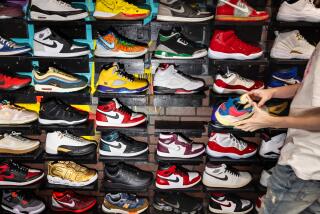Worthy of the Louvre, or the Salvation Army
- Share via
ST. PAUL, Minn. — Justin Walker is big on shoes.
He owns lots of them--a dozen pairs, maybe more. Red shoes and yellow shoes, play shoes and dress shoes, the clunky black work boots he’s wearing now.
Much as he appreciates shoes, however, Walker does not consider them art. Especially not when they’re tacked up by the thousands all over a house he walks by every day.
“Maybe it’s art to some people,” he says, dutifully considerate of other tastes. Then he peers again at the house, its ratty siding bristling with shoes of every description. There are white toddler sneakers. There are beaded blue moccasins. There are yellow rain boots and black flip-flops, polka-dot deck shoes and red high heels. There are lots of very dirty gray laces.
“It’s . . . different,” Walker says at last.
Yes, it’s different. But is it art?
“Not,” he says finally, “to me.”
And not to many others who live and work near the Shoe House, a local landmark that has drawn tourists--and questions--ever since Tyree Guyton, a Detroit artist specializing in urban junkscapes, created it in August 1996.
“I don’t have any idea what to think about it,” says Burlie Burnett, a mechanic who works nearby. Upon reflection, however, he comes up with a position--and a firm one at that: “They should tear it down.”
Such disparaging comments, of course, don’t disqualify the Shoe House as art. “If all the art in museums were put up for public vote, there would be very few things left in museums,” says Seymour Rosen, who heads a nonprofit group dedicated to saving folk art.
Beyond its in-your-face insistence that art can bloom in the most unlikely of contexts, the Shoe House is intended to symbolize diverse people coming together in harmony. Each sole represents a soul.
Art experts aren’t sure that message comes across, but they delight in the whimsy and color of the place nonetheless. “Fabulous,” Lyndel King, chief curator of the Weisman Art Museum, calls it. “A piece of wacky, eccentric folk art.”
Wacky, eccentric junk is more like it, Ying Vang responds.
And although he’s no curator, his opinion matters.
That’s because Vang bought the Shoe House last month, after it had sat on the market for more than a year. He immediately announced plans to redecorate. “It might look good to someone else,” he says, “but not to me.”
A Hmong immigrant who believes shoes belong on feet, Vang finds it odd that someone can tack penny loafers and bedroom slippers on a turn-of-the-century Craftsman house and call it art. “What does that mean?” he asks, baffled.
He won’t waste much time pondering the answer. Vang plans to rent out the house, and he figures most tenants could do without shoelaces rapping on the windows and the musty smell of old leather after rain. As soon as he can get a ladder and a crowbar, he vows, the Shoe House will be unshod.
Guyton’s fans say they’re disappointed to be losing the Shoe House, especially since the city of Detroit recently demolished several of the artist’s other works: abandoned buildings decorated with painted polka dots and encrusted with all sorts of scavenged cast-offs, from broken dolls to vacuum cleaners. Guyton, 43, is suing Detroit for his loss. He doesn’t plan any similar protest in St. Paul, however, as the Shoe House was never intended to be permanent.
Guyton decorated the house on commission from the Minnesota Museum of American Art and at the invitation of the owner. He hoped the project “could set a precedent in other urban centers around the country,” according to his agent, Jenenne Whitfeld.
Folk art lovers from far-flung cities did make sole-searching pilgrimages to the Shoe House. But it never became a catalyst for urban renewal, even in its own neighborhood. Locals say drug pushers and prostitutes still haunt the fraying streets around the Shoe House. Having fabled art--or junk--right there on Charles Avenue hasn’t done much to stop the stabbings and the shootings and the babies born in parking lots.
So, although he appreciates the Shoe House as a “conversation piece,” neighborhood repairman Bob Schilling figures the area can do without it. “It’s already served its purpose,” he says. “Whatever that was.”
More to Read
Sign up for The Wild
We’ll help you find the best places to hike, bike and run, as well as the perfect silent spots for meditation and yoga.
You may occasionally receive promotional content from the Los Angeles Times.






